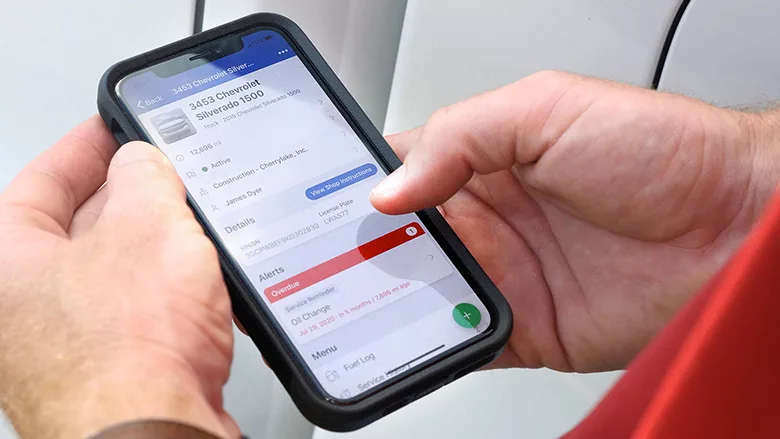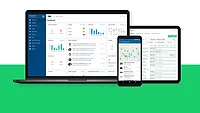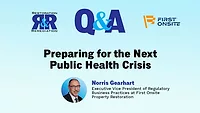Preparing Your CAT Restoration Fleet for Crisis

Photo credit: Fleetio
While crises can take many forms, standardizing a response plan to prepare for such events can help ensure your fleet minimizes downtime while maximizing safety. The thoroughness of your fleet’s response plan and protocols allows your organization to remain informed and ready to act during stressful times.
The Many Faces of Disaster
Pandemics and natural disasters are impossible to predict, but planning ahead to best tackle unforeseen events is manageable. Your fleet and drivers are your most important assets, and ensuring safety despite external forces is a top priority.
Extraordinary circumstances can ebb and flow but still have the potential to swell to daunting heights at the drop of a dime. For example, epidemics of the last few decades, like Ebola and H1N1, were limited to confined geography and had little impact on areas in North America. Conversely, the COVID-19 pandemic quickly spread and, within months, over 100 countries reported cases of the virus. A proactive safety approach to outbreaks, epidemics and pandemics is essential due to the uncertainty of these events and the speed at which they can escalate.
Natural disasters are another type of crisis that can have a tremendous impact on a fleet’s daily operations. While some natural disasters and storm seasonalities can be predicted, 2021 presented an interesting pattern that could represent a shift in predictable weather patterns. Common natural disasters in the U.S. include:
- Hurricanes: These storms occur annually in the Southeast, usually a few large storms impacting a specific region more than others. The 2021 hurricane season was the sixth consecutive year with above-average Atlantic hurricanes, and marks the first time the number of hurricanes have exhausted the list of 21 storm names for two consecutive seasons.1
- Flooding: Floods are very common across the Midwest, South and Northeast regions due to the rainfall and waterways. Late spring through summer is typically the worst time of year for flooding. 2021 has been the deadliest flood year since 2017. Over the past decade, about 58% of flood-based fatalities are vehicle-related.2
- Tornadoes: Also common in the Midwest and South, tornadoes often occur during dramatic changes in temperature during the spring and summer season. In 2021, there were over 1,300 tornadoes in the U.S., with December — surprisingly — holding one of the worst tornado outbreaks recorded in the U.S.3,4
- Earthquakes: Possible anywhere, the West Coast is more susceptible to earthquakes due to the location of tectonic plates. In 2021, the largest earthquake in the U.S. in more than 50 years hit southwest of Kodiak Island, Alaska, measuring a whopping 8.2 magnitude.5
- Wildfires: Generally occurring on the West Coast, wildfires are usually caused by dry conditions, lightning strikes, high temperatures and high winds. In 2021, there were just under 60,000 wildfires in the U.S. claiming roughly 7.12 million acres of land.6
Whether it’s a natural disaster or pandemic, the ability to remove uncertainty and restore confidence are powerful steps to ensure safety and maintain productivity. Having a crisis-preparedness plan in place ensures stakeholders across your entire operation are on the same page and enables drivers and operators across your fleet to be as safety-prepared as possible.
What to Think About When Crisis Planning
Set Safety Procedures Ahead of Time. Most organizations already have some type of safety policy in place for daily operations. After the rise and subsequent waves of COVID, some fleets have even created inspections and standard operating procedures (SOPs) around biological-based threats to ensure drivers have access to appropriate personal protection equipment (PPE) and can take steps to minimize exposure risks.
When thinking about crisis planning, take into consideration the most likely events to take place where your fleet operates. For example, if you’re in a high-risk flood zone, ensure your team knows evacuation routes, as well as when it’s no longer safe to remain in a vehicle. You can get natural disaster evacuation and crisis safety information from the FEMA website or your local fire or police departments.
Once you’ve outlined your crisis safety procedures, be certain everyone is made aware of them. Create signage and hang it in communal areas where drivers and operators can see. You can also create documentation to either print or email to employees for easy access. Have available copies handy and be willing to go over any changes or revisions. Getting feedback from your team can help you simplify your crisis safety policy so that drivers can make quick decisions in the field when needed.
It’s also important to go over any and all safety procedures when onboarding new employees and to provide access to safety documentation. Setting a precedent when a new driver joins your company can keep expectations aligned and prevent misunderstandings.
Know the Operational Status of Fleet Assets. While having a crisis safety policy in place is a great start in overall crisis-preparedness planning, it can be completely negated if your fleet assets are functioning less than optimally.
If a top concern for fleet managers and administrators is driver safety, then so is making efforts to ensure vehicles and equipment are safe for drivers and workers to operate under any circumstance. Drivers should be able to focus on their tasks and have peace of mind that their safety isn’t compromised — especially during a natural disaster or pandemic.
Vehicle inspections are the first line of defense in keying in on vehicle health and should be performed routinely. Preferably, inspections should be performed daily or before an operator uses a mobile asset. The insights you gain from inspections can contribute to your maintenance schedules, initiate new maintenance tasks and keep mobile assets in optimal operating condition.
Telematics devices are used by a variety of fleets to monitor vehicle locations through GPS tracking for productivity and safety purposes. Since natural disasters or severe weather can hinder a driver’s ability to instantly communicate, using telematics to track vehicles provides real-time driver location insight to ensure your team isn’t in harm’s way. Additionally, leveraging telematics devices provides visibility into vehicle conditions with immediate diagnostic trouble code (DTC) recognition and driver behavior monitoring.
Data from telematics devices can sync directly to fleet management software, consolidating all your fleet data onto a single platform for maximum visibility. Not only does this allow for real-time updates into driver insights, such as speed and harsh braking and cornering, but it also allows you to see the status of assets at a glance. Easily determine which vehicles are active, out of service or in the shop and see what issues a vehicle has so you aren’t sending a driver out in unsafe conditions.
Create Clear Lines of Communication. Effective communication is one of the simplest approaches to control but is often overlooked. During a crisis, fleet-wide communication is of the utmost importance. Each person involved in your operation should not only be aware of procedures but must also have the means to communicate any questions, concerns or updates in real time.
When developing a crisis-preparedness plan, you should establish communication tools between drivers, dispatchers and fleet managers. Modern fleet management software that pairs with a mobile app allows teams to communicate issues in real time. Any status updates are logged in the software and app instantly, so anyone with administrative access can oversee updates and remain informed.
Additionally, every person in your organization should have phone contacts for fleet managers and administrators. When dealing with natural disasters, road conditions could be compromised and lead to safety hazards. If road conditions are unfit for safe driving due to damage or flooding, drivers should communicate this immediately. Necessary precautions should always be taken. To avoid hazardous areas, dispatchers can provide alternative routes or designated pull-off locations. You can also establish a check-in frequency during emergency situations to promote consistent contact with anyone in the field. This adds another layer of security for your drivers.
Vehicles should also be equipped with mobile device chargers. Phone chargers are very inexpensive and can be stowed in the vehicle’s center console. In the event of an emergency, drivers will have the means to keep their mobile devices powered to maintain an open line of communication.
Get Fleet Data at a Glance
Maximizing fleet data visibility with fleet management software can help ensure your fleet assets are running optimally and safely while allowing you to see who’s operating what asset, where and when. Real-time notifications alert you to any issues that need to be addressed, and drivers can report problems that occur on the road or on the job site via the mobile app. Fleet management software helps tighten preventive maintenance schedules, streamline maintenance workflows and promote fleet-wide communication so your team can be as prepared as possible in the event of a crisis.
If the next few years are anything like the last, we’re sure to experience unexpected circumstances and unforeseen disasters. No matter the circumstances, the size of your fleet or the industry in which you operate, a crisis can strike at any moment, and the true ability to weather any storm hinges on your ability to be prepared and flexible to act.
Reference:
- https://weather.com/safety/floods/news/2021-09-13-flood-deaths-2021-united-states
- https://weather.com/safety/floods/news/2021-09-13-flood-deaths-2021-united-states
- https://www.spc.noaa.gov/climo/torn/STAMTS.txt
- https://www.weather.gov/ohx/20211211
- https://earthquake.alaska.edu/2021-seismicity-year-review
- https://www.predictiveservices.nifc.gov/intelligence/2021_statssumm/annual_report_2021.pdf
Looking for a reprint of this article?
From high-res PDFs to custom plaques, order your copy today!








